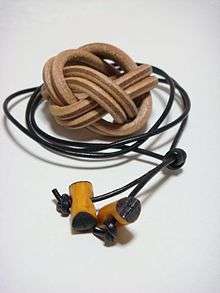Boondoggle
A boondoggle is a project that is considered a waste of both time and money, yet is often continued due to extraneous policy or political motivations.
Etymology

"Boondoggle" was the name of the newspaper of the Roosevelt Troop of the Boy Scouts, based in Rochester, New York, and it first appeared in print in 1927.[1] From there it passed into general use in scouting in the 1930s.[2] It was attributed to a boy scout from Rochester who coined the term to describe "a new type of uniform decoration". After the presentation of honorific boondoggles at a World Jamboree, the use of the word spread to other troops and branches.[3] An Oakland scout troop presented a "boondoggle" as an award for attendees who spent seven days and nights at Camp Dimond.[4] That boondoggle was described as a "red leather strip which terminates in a red wooden diamond on which is painted the number 1930."[5] The "boondoggle" was described in the Ogden Standard-Examiner in 1930 as a hand-made item crafted from brightly colored leather strips.[6] In 1931, it was similarly described as a "bright lanyard made of leatherstrip".[7]
Early usage

In 1935, a New York Times article reported that more than $3 million had been spent on recreational activities for the jobless as part of the New Deal. Among these activities were crafts classes, where the production of "boon doggles," described in the article as various utilitarian "gadgets" made with cloth or leather, were taught.[8] The phrase became popular due to its use by the flamboyant criminal lawyer Lloyd Paul Stryker.
In her 1993 memoir Nothing But the Truth, journalist Marguerite Young wrote of the 1930s:
I thought official figures and events seemed to say the biggest thing was relief–feeding the hungry, made work such as raking leaves which gave the English language a new word, boondoggle . New Dealers said the economy was "recuperating." Even as Earl Browder and Clarence Hathaway were meeting with "study groups" on Capitol Hill on the quiet, people associated with the Communist Party were pushing even harder.[9]
Dynamics
The term "boondoggle" may also be used to refer to protracted government or corporate projects involving large numbers of people and usually heavy expenditure, where at some point, the key operators, having realized that the project will never work, are still reluctant to bring this to the attention of their superiors. Generally there is an aspect of "going through the motions"—for example, continuing research and development—as long as funds are available to keep paying the researchers' and executives' salaries.
The situation can be allowed to continue for what seems like unreasonably long periods, as senior management are often reluctant to admit that they allowed a failed project to go on for so long. In many cases, the actual device itself may eventually work, but not well enough to ever recoup its development costs.
Another example is the RCA "SelectaVision" video disk system project, begun in the early 1960s and continuing for nearly 20 years, long after cheaper and better alternatives had come to market. RCA was estimated to have spent about $750 million (1985 dollars) (equivalent to $1.65 billion in 2014 dollars) on this commercially nonviable system, which was one of the factors leading to its sale to GE and later breakup in 1986.
.jpg)
The F-35 Joint Strike Fighter program has suffered massive cost and schedule overruns and the fighter's military utility is the subject of heated controversy, yet the program continues to be the highest priority procurement activity for the United States Department of Defense.[11] The Zumwalt-class destroyer has been described similarly.[12]
The Suvarnabhumi Airport in Bangkok, Thailand involved an extremely long planning cycle, cost overruns, allegations of corruption, and, when opened, was criticized for its poor construction.[13]
The Lower Churchill Project in Newfoundland and Labrador is a hydroelectric project currently under construction that is currently suffering major cost overruns and protracted schedule delays. Current Nalcor Energy CEO Stan Marshall has described the project as a boondoggle.[14]
Successful boondoggles

While cost overruns are a common factor in declaring a project a boondoggle, that does not necessarily mean the project has no benefit. Overruns are common, even with successful projects, and the benefits of a project may ultimately outweigh even steep costs. For example, the cost of construction of the Sydney Opera House ballooned over 1,400 percent, but the building has since become an icon for the city and for Australia.
Another example is "Cockcroft's Folly" – a set of air scrubbers added at great expense and complication to the Windscale nuclear reactor late in the project's construction. Years later, the amount of radioactive fallout released by the 1957 Windscale fire was substantially reduced by the presence of these scrubbers.[15]
The Hubble Space Telescope was described as a "techno turkey" after its launch in 1990, when it was discovered that a flaw in its optics made it unable to carry out most of its science objectives. A repair mission in 1993 restored its capabilities, and successive maintenance missions have allowed it to be an invaluable tool for observation and understanding of the universe for decades.[16]
See also
References
- ↑ "Scouts of Roosevelt Troop Plan Contest". Rochester Democrat and Chronicle. 1927-12-04. p. section 3, p. 15.
- ↑ "'Boondoggle'". The Jacksonville Daily Journal. 21 Sep 1930. p. 11. Retrieved 2017-05-30 – via Newspapers.com.
- ↑ "Origins of the word 'boondoggle'". The Decatur Herald. 1931-07-19. p. 9. Retrieved 2017-05-30.
- ↑ "Camp Dimond, Boy Scouts of America".
- ↑ "Scouting, boondoggles". Oakland Tribune. 1931. p. 25. Retrieved 2017-05-30.
- ↑ "'Boondoggle' camp mystery". The Ogden Standard-Examiner. 1930-06-01. p. 22. Retrieved 2017-05-30.
- ↑ "Materials ready for handicraft". The Ogden Standard-Examiner. 1931-06-07. p. 22. Retrieved 2017-05-30.
- ↑ "$3,187,000 relief is spent to teach jobless to play; $19,658,512 voted for April; 'Boon Doggles' Made". New York Times. April 4, 1935.
- ↑ Young, Marguerite (1993). Nothing but the Truth. Carlton. pp. XXX (boondoggle). Retrieved February 25, 2017.
- ↑ "Xanadu re-boot is salvage operation | NJ.com". Blog.nj.com. Retrieved 2014-05-12.
- ↑ "How the F-35 boondoggle shows that deficit hawkery is a sham". The Washington Post. Retrieved 2014-08-14.
- ↑ "How the Navy's Zumwalt-Class Destroyers Ran Aground".
- ↑ Thongrung, Watcharapong (2007-01-26). "Minister Admits: Some airlines afraid to use new airport". The Nation. Retrieved September 3, 2016.
- ↑ "Muskrat Falls Price Tag Almost Doubles At $11.4-Billion".
- ↑ Leatherdale, Duncan (November 4, 2014). "Windscale Piles: Cockcroft's Follies avoided nuclear disaster" – via www.bbc.co.uk.
- ↑ Overbye, Dennis (November 7, 2006). "Hubble, NASA's Comeback Kid, Survives to See a New Dawn" – via NYTimes.com.
Further reading
- Quinion, Michael. "Boondoggle". World Wide Words. Retrieved February 19, 2005.
- Blitstein, Ryan. "Derailing the Boondoggle" (PDF). Miller-McCune. Retrieved May 19, 2015.